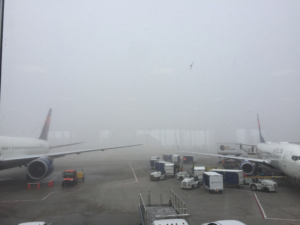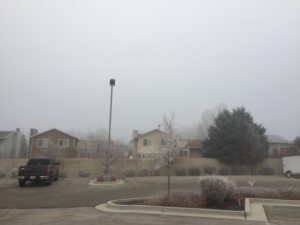 Every year between December and February, Salt Lake City, Utah, has some of the worst air quality in the nation. For those that don’t live in Utah, they might be surprised that a city with a metro population just over 1.1 million would have such terrible air quality. During these three months of poor air quality (known as “the inversion”), there has been a policy focus on individuals reducing their carbon footprint, and while some measures have been taken, they tend to fall short because they do not sufficiently limit the larger contributions of traffic due to urban sprawl and emissions from industry.
Every year between December and February, Salt Lake City, Utah, has some of the worst air quality in the nation. For those that don’t live in Utah, they might be surprised that a city with a metro population just over 1.1 million would have such terrible air quality. During these three months of poor air quality (known as “the inversion”), there has been a policy focus on individuals reducing their carbon footprint, and while some measures have been taken, they tend to fall short because they do not sufficiently limit the larger contributions of traffic due to urban sprawl and emissions from industry.
In wintertime, there is generally a warmer layer of air at ground level and a cold layer above. The temperature inversion reverses this, trapping a dense layer of cold air at ground level with the warm air above acting as a lid. This is worsened by the Wasatch Front valleys that act as a bowl keeping the dense layer of cold air and pollutants trapped. Normally, the pollutants are filtered out quickly with vertical mixing in the atmosphere, but during the winter months the particulate matter (or soot) from automobiles, industry, wood burning and fugitive dust create a public health problem. It is quite clear to everyone that lives in Wasatch Front Area that air quality is a huge problem and that action needs to be taken to limit emissions.
We know that humans cannot stop the temperature inversion from happening, however, we can limit emissions and move to renewable energy sources rather than fossil fuels, which contribute greatly to the particulate matter in the air. Actions have been taken by the city to enact a ban on wood burning on designated mandatory action days as well as an idle-free ordinance which enacts a fine for cars idling for more than two minutes at a time. What these policies leave out is the large amount of pollution from traffic due to urban sprawl, where driving is often the most practical (or only) option to get to work.
In 1999, the first electric TRAX light rail line was available to the public. The TRAX has certainly been a step in the right direction, however, much more is needed such as expanded and improved public transit and incentives and infrastructure for electric vehicles, as well as urban planning to reduce sprawl and eliminate the need for long commutes.
 We must not forget to address the pollution from large industries, like the five oil refineries owned by Chevron and Andeaver, as well as mining operations and expanding sand pits south of Salt Lake City. We must continue to fight for clean air in Utah and work not only to reduce emissions from individual actions, but also put pressure on the city to tighten regulations on industry and shift away from fossil fuels to renewable non-polluting sources of energy.
We must not forget to address the pollution from large industries, like the five oil refineries owned by Chevron and Andeaver, as well as mining operations and expanding sand pits south of Salt Lake City. We must continue to fight for clean air in Utah and work not only to reduce emissions from individual actions, but also put pressure on the city to tighten regulations on industry and shift away from fossil fuels to renewable non-polluting sources of energy.
While we must keep up the pressure on government to restrict big polluters to protect public health and the climate, we must understand that under capitalism the system is rigged in favor of the corporations. How regulatory agencies work provides a glimpse at just how incapable the capitalist system is at addressing the crisis. Governments can only limit industry insomuch as tightening regulations does not impose an undue financial burden on the polluters, regardless of public health implications. When a new regulation is adopted for oil refineries, as an example, those refineries can then sue the regulatory agency stating the mandatory upgrades in new emission abatement technologies will hurt their profit margin and hinder their ability to operate.
In the absence of mass sustained public pressure, the courts generally rule in favor of industry, who have fleets of high-paid lawyers far beyond what any public agency budget could afford. Under capitalism, we must continue to fight for more comprehensive solutions to protect public health and the planet, while at the same time fighting for a socialist system that takes away the power of the corporations and puts in the the hands of the people for the benefit of all.





